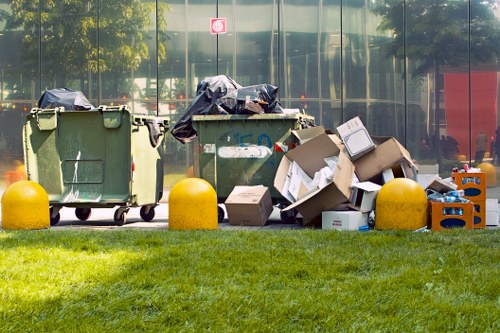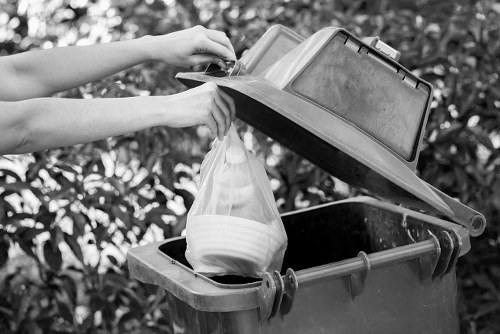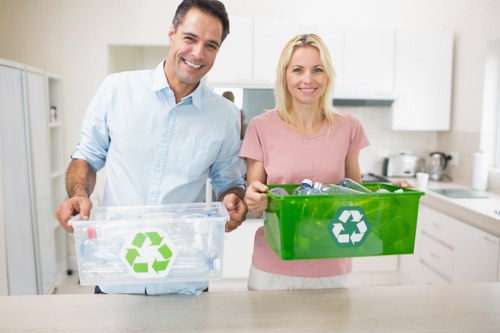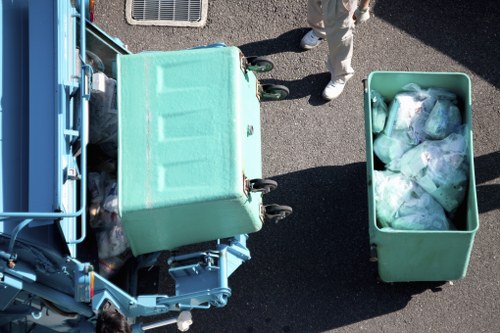Comprehensive Guide to Garden Clearance in White Goods Recycle
Understanding Garden Clearance

Garden clearance is an essential task for homeowners looking to maintain a tidy and functional outdoor space. It involves the removal of unwanted plants, debris, and obsolete items that may clutter your garden. Effective garden clearance not only enhances the aesthetic appeal of your property but also contributes to a healthier and more sustainable environment.
When planning a garden clearance, it's crucial to consider the proper disposal and recycling methods for various materials. This is where white goods recycle services come into play, ensuring that appliances and other bulky items are handled responsibly.
White goods, such as refrigerators, washing machines, and dishwashers, often find their way into gardens over time due to renovations, upgrades, or simply discarding old appliances. Properly recycling these items during garden clearance is vital to minimize environmental impact and promote sustainability.
The Importance of Recycling White Goods

Recycling white goods during garden clearance offers numerous benefits. Firstly, it reduces the amount of waste that ends up in landfills, alleviating the strain on these facilities and preserving natural resources. Many white goods contain recyclable materials like metal, plastic, and glass, which can be repurposed to create new products.
Additionally, recycling helps conserve energy. Manufacturing products from recycled materials typically consumes less energy compared to producing them from virgin materials. This energy savings translates into reduced greenhouse gas emissions, contributing to the fight against climate change.
Moreover, recycling white goods supports the local economy. Recycling facilities create jobs and stimulate economic growth by processing and repurposing materials. By choosing to recycle, homeowners can play a part in fostering a sustainable and economically viable community.
Steps to Effective Garden Clearance

Embarking on a garden clearance project involves several key steps to ensure efficiency and sustainability. Here’s a comprehensive guide to help you through the process:
- Assessment: Begin by evaluating the extent of the clearance needed. Identify the items to be removed, including plants, debris, and white goods.
- Planning: Develop a clear plan outlining the tasks, resources required, and the sequence of activities. This step ensures that the project runs smoothly and efficiently.
- Sorting: Categorize items based on their nature – recyclables, non-recyclables, and hazardous materials. Proper sorting facilitates effective recycling and disposal.
- Removal: Safely remove the identified items from the garden area. Ensure that heavy or bulky items are handled with care to avoid damage to the property or injury.
- Transport: Arrange for appropriate transportation of the cleared items to recycling centers or disposal facilities.
- Restoration: After clearance, consider restoring the garden space by adding compost, planting new vegetation, or redesigning the layout for improved functionality.
Recycling White Goods: Best Practices

Recycling white goods requires adherence to specific best practices to ensure environmental safety and compliance with regulations. Here are some guidelines to follow:
- Check Local Regulations: Different regions have varying rules regarding the disposal and recycling of white goods. Familiarize yourself with local laws to ensure compliance.
- Contact Recycling Centers: Reach out to authorized recycling centers that accept white goods. They can provide information on the required procedures and any associated costs.
- Prepare Appliances: Before recycling, ensure that white goods are clean and free from any hazardous substances. This step facilitates easier processing at recycling facilities.
- Schedule Pickup: Many recycling centers offer pickup services for bulky items. Scheduling a pickup can save time and effort.
- Secure Data: If recycling white goods like computers or smart appliances, ensure that all personal data is securely erased to protect your privacy.
Benefits of Professional Garden Clearance Services

Opting for professional garden clearance services can significantly enhance the efficiency and effectiveness of your project. Here are some advantages of hiring experts:
- Expertise: Professionals possess the necessary skills and knowledge to handle various clearance tasks, ensuring that the process is conducted safely and thoroughly.
- Time-Saving: Hiring a team can expedite the clearance process, allowing you to focus on other aspects of your home or garden.
- Proper Disposal: Professionals ensure that all items, especially white goods, are disposed of in an environmentally responsible manner, adhering to recycling protocols.
- Cost-Effective: While there is an upfront cost, professional services can save money in the long run by preventing potential fines and ensuring efficient recycling.
- Comprehensive Services: Many garden clearance companies offer additional services such as landscaping, garden design, and maintenance, providing a one-stop solution for all your garden needs.
Environmental Impact of Responsible Garden Clearance
Engaging in responsible garden clearance practices has a profound environmental impact. By recycling white goods and other materials, homeowners contribute to conserving natural resources and reducing pollution. Here’s how:
- Reduction in Landfill Waste: Proper recycling minimizes the volume of waste sent to landfills, decreasing soil and water contamination.
- Resource Conservation: Recycling materials reduces the need for extracting and processing raw materials, preserving ecosystems and biodiversity.
- Energy Efficiency: As mentioned earlier, recycling consumes less energy than producing new materials, leading to lower carbon emissions.
- Pollution Prevention: Proper disposal of appliances prevents the release of harmful substances like refrigerants and heavy metals into the environment.
Choosing the Right Recycling Service
Selecting a reliable recycling service is crucial for a successful garden clearance project. Consider the following factors when making your choice:
- Reputation: Look for services with positive reviews and a solid reputation in the community. Trusted companies are more likely to provide quality service.
- Certification: Ensure that the recycling service is certified and adheres to industry standards for environmental safety.
- Services Offered: Choose a service that offers comprehensive solutions, including pickup, transportation, and processing of white goods.
- Cost: Compare prices from different providers to find a service that offers good value without compromising on quality.
- Customer Support: Responsive customer support is essential for addressing any concerns or questions during the clearance process.
DIY vs. Professional Garden Clearance
Deciding between a do-it-yourself (DIY) approach and hiring professionals for garden clearance depends on several factors. Here’s a comparison to help you make an informed decision:
- Cost: DIY is often cheaper initially, but professional services can save money in the long run by ensuring efficient recycling and disposal.
- Time: DIY projects can be time-consuming, especially for large gardens. Professionals can complete the task more quickly.
- Expertise: Professionals have the skills and equipment to handle difficult clearance tasks, reducing the risk of damage or injury.
- Sustainability: Professional services are more likely to follow proper recycling protocols, ensuring environmental sustainability.
- Customization: Professionals can provide tailored solutions to meet specific garden clearance needs, enhancing overall effectiveness.
Maximizing Space Post-Clearance
After completing garden clearance and recycling white goods, it’s important to make the most of the newly available space. Here are some ideas to help you transform your garden:
- Landscaping: Invest in professional landscaping to design a beautiful and functional outdoor space. This can include planting new trees, installing garden beds, and adding decorative elements.
- Outdoor Living Areas: Create inviting outdoor living spaces such as patios, decks, or gazebos to enjoy with family and friends.
- Gardening: Start a vegetable or herb garden to grow your own produce, promoting sustainability and self-sufficiency.
- Recreational Features: Incorporate features like a barbecue area, fire pit, or water fountain to enhance the recreational value of your garden.
- Storage Solutions: Install storage sheds or outdoor cabinets to keep tools and gardening equipment organized and easily accessible.
Sustainable Practices in Garden Clearance
Embracing sustainable practices during garden clearance ensures that the environmental impact is minimized. Here are some sustainable approaches to consider:
- Composting: Composting garden waste such as leaves, grass clippings, and plant debris transforms them into valuable fertilizer for your garden.
- Reusing Materials: Repurpose old materials and appliances creatively. For example, turn an old washing machine into a water feature or planter.
- Minimizing Waste: Plan your clearance to reduce the amount of waste generated. This can involve donating usable items to charities or selling them second-hand.
- Eco-Friendly Disposal: Choose recycling services that follow environmentally friendly disposal methods, ensuring that materials are processed responsibly.
- Energy Conservation: Use energy-efficient tools and equipment during clearance to reduce overall energy consumption.
Legal Considerations in Garden Clearance
Undertaking garden clearance involves adhering to various legal requirements to avoid fines and legal issues. Important legal considerations include:
- Permits: Some regions require permits for large-scale clearance or the removal of certain items. Check with local authorities to determine if permits are needed.
- Disposal Regulations: Follow local regulations regarding the disposal of white goods and other materials. Improper disposal can result in fines and environmental penalties.
- Zoning Laws: Ensure that your garden clearance complies with zoning laws, especially if you plan to make significant changes to the property.
- Environmental Protection: Adhere to environmental protection laws that govern the removal of plants, trees, and other natural elements.
Cost Factors in Garden Clearance
The cost of garden clearance can vary based on several factors. Understanding these factors can help you budget effectively:
- Size of the Garden: Larger gardens require more time and resources to clear, increasing the overall cost.
- Volume of Waste: The amount of waste generated during clearance affects disposal and recycling costs. More waste typically means higher expenses.
- Type of Materials: Certain materials, especially hazardous ones, may require special handling and disposal, which can add to the cost.
- Accessibility: Gardens with limited access may require additional equipment or labor, affecting the total cost.
- Additional Services: Optional services like landscaping, composting, or storage solutions can increase the overall cost depending on your needs.
Enhancing Garden Health Post-Clearance
After completing garden clearance and recycling white goods, it’s essential to focus on the health and vitality of your garden. Here are some tips to ensure your garden thrives:
- Soil Health: Improve soil quality by adding compost and organic matter. Healthy soil supports robust plant growth.
- Plant Selection: Choose a variety of plants that are well-suited to your climate and soil type. Diverse plant species can enhance biodiversity and resilience.
- Water Management: Implement efficient watering systems like drip irrigation to conserve water and ensure plants receive adequate moisture.
- Pest Control: Use natural pest control methods to protect your plants without harming the environment.
- Regular Maintenance: Maintain your garden through regular pruning, weeding, and monitoring to keep it healthy and vibrant.
Community Benefits of Garden Clearance and Recycling
Engaging in garden clearance and recycling white goods not only benefits individual homeowners but also has positive effects on the community. Here’s how:
- Environmental Stewardship: Collective efforts in recycling and proper disposal reduce the community’s overall environmental footprint.
- Enhanced Aesthetics: Clean and well-maintained gardens contribute to the visual appeal of neighborhoods, fostering a sense of pride and community spirit.
- Resource Sharing: Recycling programs often involve sharing resources and materials, promoting a culture of sustainability and cooperation.
- Economic Growth: Recycling initiatives can stimulate local economies by creating jobs and supporting green businesses.
- Educational Opportunities: Community-based recycling programs can educate residents about sustainable practices and environmental responsibility.
Future Trends in Garden Clearance and Recycling
The landscape of garden clearance and white goods recycling is continually evolving with advancements in technology and changes in consumer behavior. Here are some future trends to watch:
- Smart Recycling Solutions: Integration of smart technologies in recycling processes will enhance efficiency and traceability, making recycling more effective.
- Circular Economy Models: Emphasizing the reuse and repurposing of materials will dominate, reducing waste and promoting sustainability.
- Eco-Friendly Materials: Increased use of biodegradable and recyclable materials in white goods will simplify the recycling process.
- Community Recycling Programs: Enhanced community engagement and local recycling initiatives will foster a more sustainable environment.
- Regulatory Changes: Stricter regulations on waste disposal and recycling will encourage more responsible garden clearance practices.
Conclusion
Garden clearance integrated with white goods recycle is a pivotal aspect of sustainable living. By effectively clearing your garden and responsibly recycling appliances, you contribute to a healthier environment, conserve valuable resources, and enhance the beauty and functionality of your outdoor space. Whether you choose to undertake the project yourself or hire professional services, prioritizing eco-friendly practices ensures that your garden remains a thriving and sustainable haven for years to come.
Ready to transform your garden with efficient clearance and recycling services? Contact us today to book your service and take the first step towards a greener, more organized garden.